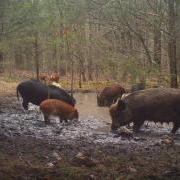feral hogs in Missouri
As I wrote in my blog of March 2016, introduced wild hogs (Sus scrofa) threaten ecosystems across the continent and on islands ranging from Hawai`i to the Caribbean.
According to an environment impact statement prepared by APHIS (see reference below), these highly adaptable, prolific, large and powerful animals cause immense damage by rooting for plant parts and invertebrates in the soil, and by wallowing to cool themselves and fend off biting insects. Pigs may root to depths of three feet below the surface. Wallows are commonly located in or adjacent to riparian or bottomland habitats. Feral hogs out-compete other animals for hard mast and also consume algae, fungi, soil invertebrates, worms, crustaceans, and bird and reptile eggs. They even feed on small vertebrate animals.
Rising feral hog populations and spread to new areas has raised concern. insert map According to John J. Mayer (reference below), the number of states with established wild boar populations is now 37. They might number as many as 11.3 million. Texas has the largest numbers, 30 to 41% of the U.S. total. Other states with high numbers are Alabama, Arkansas, California, Florida, Georgia, Louisiana, Mississippi, Oklahoma, and South Carolina.
Poison them?
One proposed response was to poison the hogs using the anticoagulant drug Warfarin – which is widely used as a rodent poison. The U.S. Environmental Protection Agency (EPA) approved the use of warfarin as a bait – Kaput® Feral Hog Bait – in January 2017 after only 16 months of review – an unprecedented brief period for a toxin. Many expressed concern, especially about possible poisoning of non-target wildlife. The National Environmental Coalition on Invasive Species was one of several groups to ask EPA to reconsider. Principal concerns raised: black bears and other wildlife could open the bait dispenser; spilled bait could be eaten by a wide variety of wildlife; scavengers could be exposed when they feed on the carcasses of poisoned pigs; hunters could also be exposed to contaminated meat. Several states considering use of the bait – including Louisiana and Texas – decided to reconsider. The Arkansas Game and Fish Commission also asked the state Plant Board to take care pending additional study of the secondary effects.
Missouri Program Expands
Meanwhile, Missouri is finding success with its aggressive and scientifically-based program, which began years ago in response to growing public concern about hog damage. As I noted in my earlier blog, in 2016, the Missouri Conservation Commission prohibited hunting of feral hogs on lands owned, leased, or managed by the Missouri Department of Conservation. Missouri took this action because hunting does not significantly reduce feral hog populations. Instead, it causes the animals to disperse – making them even more difficult to control. (Missouri has extensive material on feral hogs posted here .
The Missouri Department of Conservation is working with several partners – including other government agencies, non-government organizations, agricultural organizations and many landowners. The program has included private lands since the 1990s. However, there is an increased effort to engage more private landowners so as to place traps on more lands in the state. The outreach includes landowner workshops and presentations to various groups, as well as information provided at fairs and similar events. MDC relies largely on landowners contacting the agency when they have feral hog problems and visits to individuals.
The outreach is working; the number of landowners asking for assistance is rising.
The numbers of hogs removed has also risen. During 2016, 5,358 were removed as part of the program. During the first seven months of 2017, From January 1 through July 31, 2017 MDC and its partners removed 4,703 feral hogs. This is more than a thousand more than had been removed during the same period in 2016.
The program is not cheap; the Conservation Commission approved $1.8 million for fiscal year 2018. These funds cover primarily trapping and killing activities. Costs for MDC staff time and fuel are not included. Most of the MDC staff assisting the program do so as an additional duty. Recently, MDC has hired Mark McLain as the Feral Hog Elimination Team Leader to coordinate MDC feral hog elimination efforts statewide.
Information for this blog came in part from an MDC press release here and Alan Leary and Mark McLain of the Missouri Department of Conservation. However, the views presented here are those of the Center for Invasive Species Prevention, not the Missouri Department of Conservation.
Update:
The Missouri program removed a total of 6,561 feral hogs in 2017. From January through July 2018, the program removed 7,339 hogs (MDC press release November 2018).
Mark McLain, the MDC lead on hog eradication, said “We’ve been very strategic in our efforts, focusing on removal of whole groups of feral hogs at a time, before moving onto another area. This strategic approach is important because if we leave even a few feral hogs behind in an area, they can reproduce quickly and put us back where we started.”
McLain noted that over the 20 years when hunting feral hogs was unregulated, they spread from a few counties to over 30 counties. He warned people who continue to release feral hogs are acting illegally and will be fined.
SOURCES
Mayer, J.J. 2014. Estimation of the Number of Wild Pigs Found in the Unted States. August 2014 SRNL-STI-2014-00292, Revision 0.
Missouri Department of Conservation. 2018. Press Release: MDC and partners eliminate more than 7,300 feral hogs from Missouri’s landscape in 2018 so far. https://mdc.mo.gov/newsroom/mdc-and-partners-eliminate-more-7300-feral-hogs-missouri%E2%80%99s-landscape-2018-so-far
U.S. Department of Agriculture Animal and Plant Health Inspection Service Final Environmental Impact Statement. Feral Swine Damage Management: a National Approach May 27, 2015 https://www.aphis.usda.gov/regulations/pdfs/nepa/2015%20Final%20EIS%20Feral%20Swine%20Damage%20Management%20-%20A%20National%20Approach.pdf
We welcome comments that supplement or correct factual information, suggest new approaches, or promote thoughtful consideration. We post comments that disagree with us — but not those we judge to be not civil or inflammatory.
Posted by Faith Campbell
